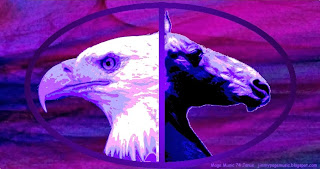~Robert Godwin, as quoted in George Case’s Jimmy Page: Magus, Musician, Man: An Unauthorized Biography
Mage Music 74
Symbols are remarkable. Without them, you couldn't read this post. Without them, you couldn't communicate on more than the most basic of levels.
Without symbols, there would be very little Magick.
Symbols can convey meaning above and beyond “what you see is what you get” (that is, the denotation or literal, dictionary meaning of a word or term). The capacity of symbols to carry richness and depth of additional meaning (connotation, or overlaid meanings that convey emotions, values, associations and nuances beyond the literal) makes symbols possibly the most valuable of all the treasures that a human might possess. For a Mage, symbols are the secret heart of ritual.
In Magick, symbols are most potent when they are maximally realized and intensely embody the desire that fuels the ritual. At their most potent, symbols are so rich that their power carries over to others. Thus a Mage whose ritual is meant to be shared with an audience - a painter or a musician, for example - can use personal symbols within that ritual that have such extremely powerful meaning that the symbols pack a punch for the audience too.
The most potent symbols must remain personal to the Mage, though. To reveal the meaning – if a Mage could even bring himself to do so – would bleed off the pressure of that power, reduce its intensity and thereby weaken the ritual.
The Eagle and the Horse
Let's use the example of the eagle and the horse to talk about denotation and connotation: An eagle is a bird, but its deeper meaning is that of wild power used as weapon. Long a symbol of power, the eagle was the Egyptian symbol for the god Horus, it was the standard of a Roman legion, and today eagle is the US emblem. Although there are much larger birds in the world, the eagle has long been held as the King of the Birds in mythology by many cultures. A predator, eagle carries a depth of meaning that includes the danger of a focused and yet unlimited power.
A horse is a mammal, but its deeper meaning is that of power shaped by human will. Horses symbolize grace, beauty, nobility, strength, speed and freedom. These meanings can transcend the normal world when the horse has wings or horns as Pegasus or unicorn. As a powerful and dangerous animal that is not a predator, horse’s power is broader focused and symbolically horse is a helper. There is great power with both horse and eagle, but horse carries a feeling of less danger in its symbolism.
Or not.
Maybe you come from a place like Alaska where there are so many eagles that they’re like pigeons and you have little respect for them. Maybe you come from a culture that eats horses, or maybe from a culture that has never even heard of either. Maybe you're scared to death of both of them.
The power of a symbol isn't in the object itself and certainly not in its name or its history, but rather what it means personally to the one who uses it.
In the right hands, a symbol can carry meaning so powerful, so potent, so filled with possibility that the symbol is the fissionable material of Magick. Such things have no names that you or I could - or should - know.





